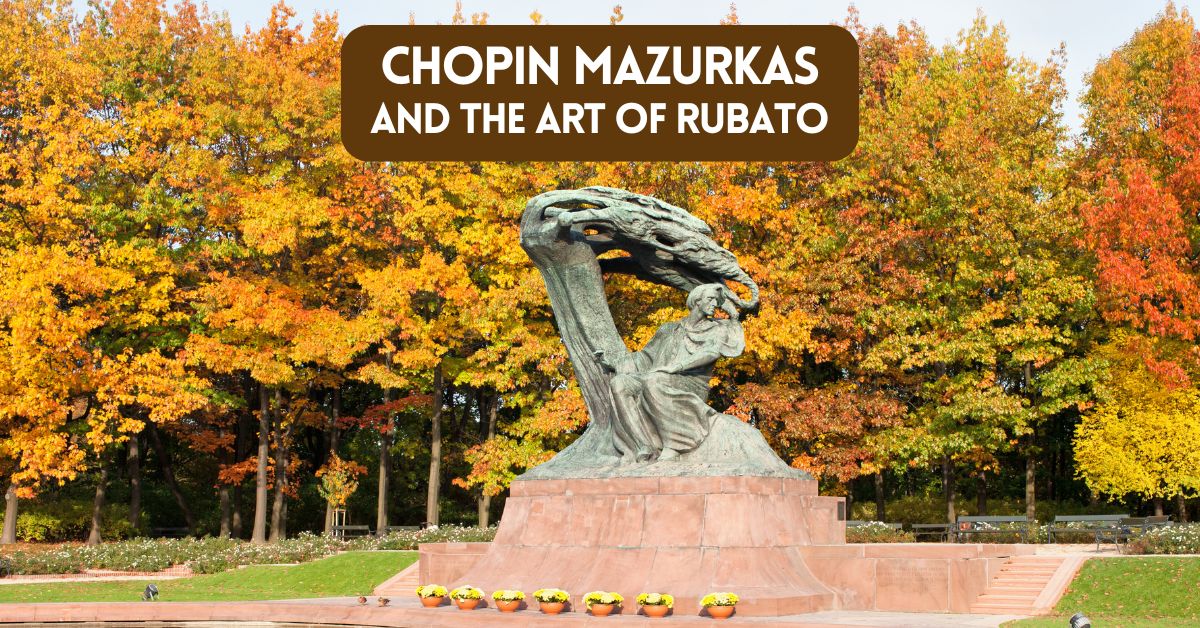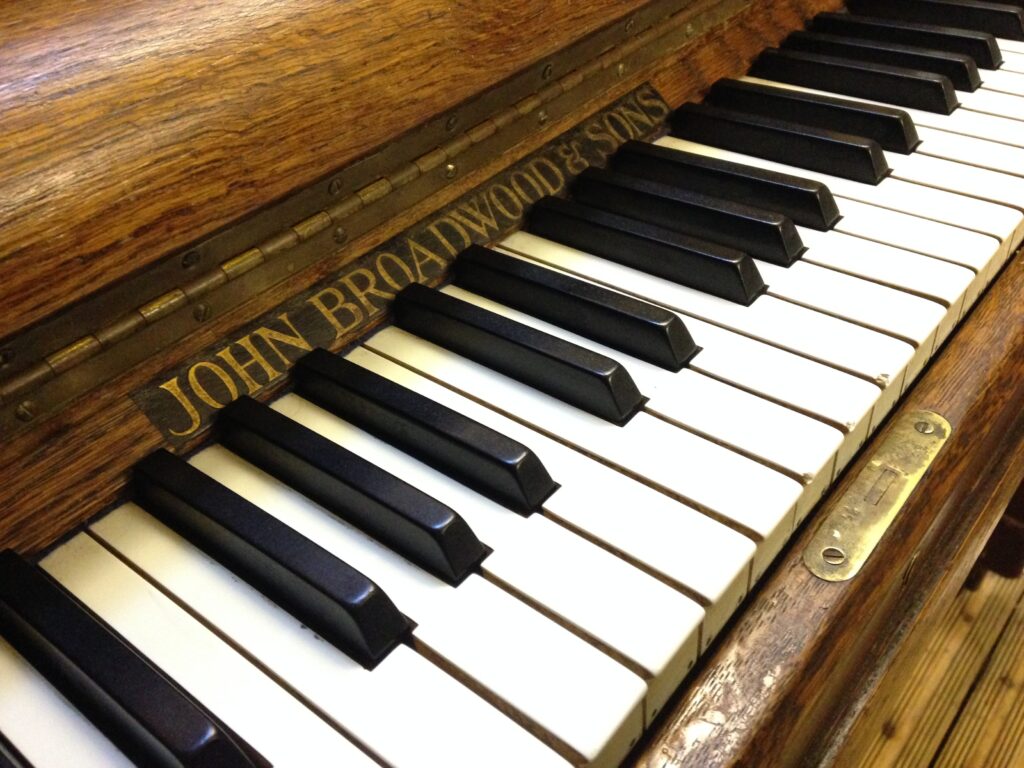Few composers capture the subtle nuances of human emotion like Frédéric Chopin. Among his many masterpieces, the mazurkas stand out as a treasure trove of emotional complexity and interpretative freedom. For pianists and classical music enthusiasts alike, these miniature gems offer an incomparable window into Chopin’s artistry—and an excellent challenge for those looking to master the elusive skill of rubato.
In this blog, we’ll explore the essence of Chopin’s mazurkas, the role of rubato in shaping their interpretation, how they differ from his waltzes, and recommendations for jumping into this captivating repertoire.
Azure Hills Music contains affiliate links and is a member of the Amazon Services LLC Associates Program. As an Amazon Associate, we earn from qualifying purchases at no extra cost to you when you purchase using one of these Amazon links. Read our disclaimer and privacy policy for more information.
What Are Chopin Mazurkas?
Chopin’s mazurkas are piano compositions inspired by traditional Polish folk dances. Composed throughout his lifetime, these 59 works are far from simplistic dance tunes—they’re introspective, intricate, and deeply personal explorations of Polish musical traditions blended with Chopin’s Romantic individuality.
Though rooted in the rhythms of the Polish mazur (a traditional peasant dance), Chopin reimagined the form. His mazurkas are intricate, intimate works often filled with unusual harmonies, adventurous modulations, and a deeply nostalgic tone. Unlike his more extroverted polonaises or elegant waltzes, the mazurkas are reflective in nature, offering a glimpse into Chopin’s deeply personal connection to his Polish heritage.
For listeners, mazurkas can evoke joy and melancholy simultaneously. For performers, they demand precision, musicality, and—most notably—an instinctive command of rubato.
Rubato in Chopin Mazurkas
If you’ve spent any time studying Romantic music, you’ve likely encountered the term “rubato.” Translating to “robbed time,” rubato refers to the subtle stretching and compressing of tempo within a phrase, creating an expressive ebb and flow. While it’s an essential tool for interpreting Chopin’s music in general, in the mazurkas, it might just be the defining characteristic.
For Chopin, rubato was not about abandoning structure or rhythm altogether. Quite the contrary—he believed in maintaining a temporal balance. To quote Chopin himself, rubato meant “stealing time from one measure only to return it later.” This respectful manipulation of timing creates a natural, almost conversational flow in the music.
Imagine a heartfelt conversation. When we speak, the cadence of our words shifts—pausing to reflect, accelerating with excitement, or slowing down to emphasize meaning. Chopin’s rubato works in the same way. His mazurkas invite you to “speak” through the piano, with your right hand exploring a sense of freedom while your left hand provides steady rhythmic grounding.
A famous metaphor suggests thinking of the left hand as a gentleman escorting a lady (your right hand) at a lively ball. The gentleman provides a solid foundation, allowing the lady—graceful and dynamic—to shine. Achieving this balance is no easy task, but when done well, it creates an enchanting illusion of freedom and control.
Mazurkas vs Waltzes
At first glance, Chopin’s mazurkas and waltzes might seem similar—their dance origins make them natural companions. However, the two could hardly be more different in spirit.
The waltzes are designed to flow. Their patterns are more straightforward, their rhythms familiar. Performers often describe playing them as an act of elegance and grace, perfect for conjuring up visions of ballroom soirées.
Mazurkas, on the other hand, break the mold. Commentators often stress the idiosyncratic rhythm, particularly the emphasis on the second beat that can feel almost imperceptibly prolonged. To many, this rhythm encapsulates the “Polish soul” within the music.
And yet, Chopin didn’t write mazurkas to be danced. Unlike their waltz counterparts, mazurkas are inward-facing. “Folk-inspired” yet elevated, they retain the pulse of their origins while offering moments of complexity and intimacy. While anyone can tackle a waltz, playing a mazurka requires heightened sensitivity to detail and nuance—especially when exploring the fine line between rhythm and rubato.
Where to Start: Recommended Mazurkas
The entire collection of Chopin’s mazurkas offers a lifetime of exploration, but for those just stepping into this world, starting with the easier pieces offers both challenge and satisfaction. Here are some great initial picks to explore the melodic charm and rubato practice:
1. Mazurka in A Minor, Op. 7, No. 2
This piece is a great entry point for its simplicity and lyrical charm. The melody invites freedom, making it an excellent practice piece for experimenting with rubato.
2. Mazurka in G Minor, Op. 67, No. 2
With its gentle melancholy and enchanting atmosphere, this mazurka is ideal for exploring depth and musical storytelling. The rhythmic structure is approachable without being overly simplistic.
3. Mazurka in B-flat Major, Op. 7, No. 1
Perfect for working on the characteristic shift in accents, this piece allows experimenting with rhythmic subtleties while maintaining a playful melodic line.
4. Mazurka in F Minor, Op. 68, No. 4
This posthumously published work is an exercise in expressing longing. While technically lightweight, it lays the groundwork for building rubato technique and emotional authenticity.
Remember, the goal isn’t simply to master the notes but to capture the music’s spirit—the quirky rhythms, the poignant melodies, and the tonal shifts that make each piece uniquely captivating.
Tips for Practicing Rubato in Mazurkas
Here are some practical steps to bring rubato to life in your playing:
- Feel the Rhythm: Start by practicing steady rhythm with the left hand before adding any expressive timing. Only introduce rubato once you’ve internalized the underlying pulse.
- Experiment with Freedom: Isolate the melody in your right hand and play it freely while the left hand provides structure. Push and pull the tempo slightly to feel expressive possibilities.
- Record And Reflect: Rubato is all about balance. Record yourself playing and listen back to see if you’re overdoing or underdoing your timing changes.
- Learn from the Masters: Listen to pianists like Arthur Rubinstein, Vladimir Horowitz, or Krystian Zimerman interpreting Chopin mazurkas. Notice how they approach rhythmic flexibility.
Embark On Your Chopin Journey
Chopin’s mazurkas offer a unique blend of technical challenges and emotional rewards, making them a mainstay in the repertoire of any serious pianist. Through their subtle rhythms and evocative melodies, these works embody the delicate balance between Romantic passion and Classical structure. And within their notes lies the key to mastering rubato—a skill that unlocks expressive potential across the piano repertoire.
Whether you’re just beginning your exploration of the mazurkas or refining your artistry, Chopin’s music invites endless discovery. Take your time, enjoy the process, and allow these timeless treasures to transform not just your playing, but also your understanding of the piano.
Happy playing, and here’s to capturing the art of Chopin’s rubato!
Thanks for visiting this page.
Arthur Dobrucki


